-
Posts
2,406 -
Joined
-
Last visited
Content Type
Profiles
Forums
Gallery
Events
Articles
Posts posted by Ian
-
-
another nice medal in your growing collection.....

Ian
-
Now the French are going overboard in their desire to mend the fence with the USA

But yes, it is an appropriate commem though.
Looks to me from the coin that Ben has told them to go fly a kite, especially with the prices they are looking to achieve from collectors.

Ian
-
I had a friend who possesses a copy of Marvin's book on Masonic medals to take a look at the first jeton and his partial response was:
I'm fairly certain that Louis XVI wasn't a Mason but I might be mistaken about that. His brother, the Duc d'Orleans was the Grand Master of France at the time of the Revolution.
Fascinating. The thinking in France is (I believe) that a secret society would not be as overt with their jetons, nor would a King be associated so directly as having his image on the obverse. This contradicts earlier thinking.
There is an earlier jeton same reverse but bearing the bust of Louis XV, probably circa 1740 -50. So if Marvin missed the Louis XVI one, he probably missed a couple of Louis XV too . Gadoury's 1991 catalogue lists three different busts with that same reverse under the category `Master Masons' and unfortunately `and masonic interests', giving the impression that it is connected to free masonery. I am of the view that the jeton lies more properly alongside such series as Experts des Batiments (du Roi).
I need to dig out my CGB catalogues as I recall Michel Prieur commenting along the lines that these items are not actually (free) masonic and that values of them had dropped off due to this. I haven't come across one with that reverse AND a Minerva bust. However, i've just posted a masonic piece with Minerva on it in the`Minerva' thread :-).
-
The French `jeton de presence' was used as a means of token payment for such things as attendance at meetings, or sitting on committees commissioned by the Government or issued as tokens of appreciation by the various offices of state including the royal households. As such the scope for these is immense. Some bodies issuing only one, others issuing a different jeton each year and over a period sometimes exceeding a century.
Although there is an ever growing band of `jeton collectors', these items are generally still mostly unheard of outside of France. I have been collecting them now for some five years or so and have been fascinated by the historical and cultural backdrop to most of these little gems. It has to be said that their individual mintages are generally numbered in the lower thousands (with some few exceptions), so none of them are exactly `common' in numismatic terms. However that does not mean that they are expensive either. Sure, many are hyper scarce and will cost a pretty penny, but there are real beauties out there that can be had for a song. I'm pretty sure that the collecting fraternity will one day waken up to this particular `sleeper' hence the reason why I grab as many as I can. :-)
Here's one that arrived with me just this morning. A jeton designed for the Guild of Master Masons by Duvivier circa 1780 and struck at La Monnaie, Paris. Note, this Guild was nothing to do with the `freemasons'. Another thing to be considered about these items is that they were produced when silver was the basis of the currency unit. Many of these `jetons' did indeed change hands in exchange for goods or services even though not exactly strictly `legal tender'.
The second one in this post is a more modern piece issued for one of the Maritime Insurance Companies. The item was, like most of this type. most probably issued to council members for attendance.




-
In case you are really really into these, Gietl just published a new two-volume catalog about Swiss shooting medals - Schützentalers, Schützenmedaillen, Schützenjetons, in German, 600 pages, and pretty much every described piece is depicted in color. The author is Jürg Richter. The not-so-neat part is this: €98 ...
Christian
Argh! For now I think i'll be sticking with Delbert R Krause's `Swiss Shooting Medals'. If I become re-addicted to these, then perhaps i'll splash out. However, there would be so much data totally lost on me due to my inability to read in German.
Ian
-
Last one for now, this time from Basel 1844.


-
Although not really a shooting medal this dates from 1804 from Zurich:
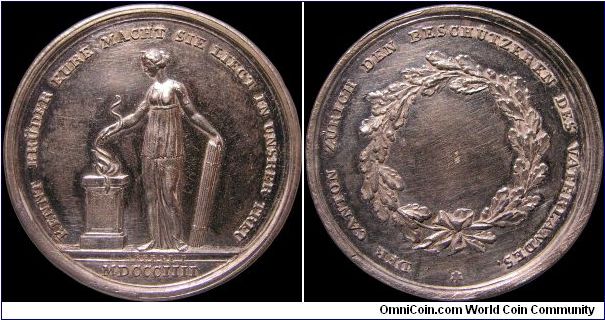
It's a protector's medal, issued to the local militia for service in defense of the country.
I'm not exactly sure when shooting medals started but they are one of the great temptations outside of the Napoleonic era for me. There have been hours at a Long Beach show where I just sit drooling over these things...
Pretty neat medal you have there. I wasn't aware of these.
The only reference I had for Swiss Shooting Medals was the Krause one of the same name (small green leatherette hardback). I gave my copy as a gift a while back to a friend in the US who was hooked on these babies a bit more than I was. So i'm now floundering concerning what is / was the earliest Swiss shooting medal. Although the Swiss tend to come to mind in connection with shooting medals (probably rightly so from an art perspective) there are german ones which are absolutely stunning too. Sadly I have none of my own to demonstrate what I mean, but the Goetz one in an adjacent thread certainly fit the bill in terms of general aesthetic merit (IMHO).
Ian
-
I don't have many more of these left to show. My interest in collecting them waned when I got hooked on jetons, but looking at them again has rekindled my own interest. Mind you, i've got a few of the more common Swiss Shooting Thalers to show after I run out of the medals

I always hear imaginary strains of the William Tell Overture when I look at this one. (excuse the poor image. I must take the time to scan it myself rather than using the original auction image).
The William Tell Overture was popularised in the US when it was chosen as the theme tune for `The Lone Ranger'. Most people in the western world (pardon the pun) know it better for the masked ranger. The medal however depicts its true origins.
Ian
-
Here's another Swiss shooting medal. This time Zurich 1895. I'm a sucker for these nice chunks of siller with pretty city view and countryside scenes. The semi- naked lady (obverse) really gets in the way of the view don't you think?


-
I have to confess that i'm not much of an admirer of Goetz's work or style, but that medal is one that i'd happily have in my collection.
-
Here's another one. This time Geneva, 1887. I have one in Silver and one in Bronze. They are the most 3 dimensional pieces I have ever come across. The photo does it no justice.


Ian
`Seasoned Anorak'
-
I was kind of hoping to entice other collectors of these pieces from out of the woodwork, but so far, i've failed :-(
Ah well, here's another one of mine. Thurgau this time.


-
A denier of Foulques V D'Anjou (coin circa 1109 -1129) arrived with me today. A denier of Hugues V de Bourgogne arrived yesterday. Scratch another two french historical figures from my hit list.
-
Swiss (and other countries) shooting medals are highly collectable. I didn't become interested in them at all until I saw this one. From the Swiss Canton of Glarus. Had to buy it. I've bought a few since, but none of them are quite so colourful.
Amazing though it may seem, the toning is indeed natural and is one of those occasions where it just seems to blend in with the coin.

-
8 maravedis coins are 28mm.
quarter dollar = 24.3mm, half dollar = 30.6mm
Yep. You're right.

Memory playing tricks on me again.It's been a while since I looked at the Isabel 8 maravedi coin. I always remebered them to be bigger than they actually are. Either that or I think of the half dollar as being smaller than it actually is.

Ian
-
Spain - 8 maravedis. mintmark on the reverse, bottom, either J, JA, or an aqueduct. The J & JA are from Jubia Mint, the aqueduct is from Segovia. According to my old 1996 edition of Krause, in VG the value starts at $5.00. Not a bad find for a quarter.
If the coin on question is larger than a quarter dollar but smaller than a half dollar, is it not more likelt to be four maravedis than eight maravedis?
Ian
-
Good history lesson, Ian. The study of coins involves the study of history, politics and economics. Coins, tokens and medals are struck for reasons. Sometimes those reasons are preserved in history mainly as a result of the survival of the coins.
Thanks mate. The history behind those two jetons was crying out to be told.
Ian
-
Hmm the Boston Tea Party... i still shudder to think of all that wasted tea. What a loss.
Ah but it could have been much worse. A small mercy perhaps, but at least it wasn't Earl Grey tea that went overboard. ;-)
-
At the outbreak of the seven years war (1756-1763) the British Admiral John Byng was charged with bolstering up the British naval base at Port Mahon, Minorca in the Mediterranean sea. He arrived only to find the island under blockade from the French fleet under the command of Galissoniere.
The vanguard of the British fleet was savaged by the French, and Byng decided to cut his losses and head for Gibraltar. The result of that decision was that the French took Minorca and with it the strategically important Port Mahon base.
It is commonly held that Byng’s squadron was ill equipped for the task he had been set and the probabilities are that he would have been well trounced if he had not withdrawn. In the event, it appears that he was made a scapegoat for admiralty incompetence as evidenced by his subsequent court martial back in England. Although cleared of cowardice he still ended up being sentenced to death for dereliction of duty. He was executed in March 1757 on HMS Monarch in Portsmouth harbour by a shot to the back of his head.
Needless to say, the French duly celebrated their victory at Port Mahon, by issuing a silver jeton commemorating the event.
The first jeton shown has the bust of Louis XV facing to the right (obverse) and an eagle flying above the clouds, wind, and stormy seas (reverse) dated 1756 and signifying the first outbreak of naval hostilities between the two nations during the war.
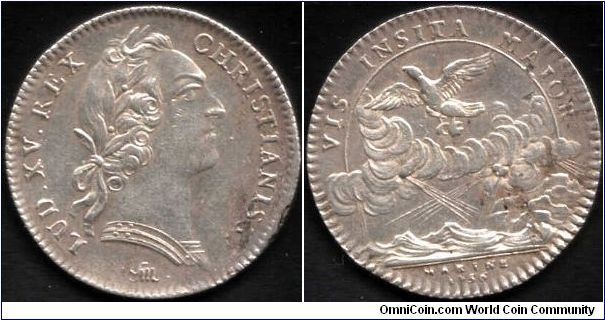
So, what does all this have to do with the Americans? Well, there are two relevances. The first being the cost of the war on Britain and the effects it had on the colonies when taxes were increased to help defray these costs. The second relevance lies with a later French victory over the Brits.
Although the Brits went on to win the seven year war, it cost them dearly in economic terms. They had borrowed heavily from bankers both at home and in the Netherlands. The national debt rocketed skywards and needed repayment. This was accomplished (rather ill advisedly) by sharp increases in taxation. Nowhere was the taxation felt more painfully than the American colonies due to the imposition of harsh duties on imported goods like sugar, tea etcetera.. The seeds of discontent were sewn big time. It is generally understood that the seven year war directly led to the overt parting of the ways between the American colonies and Britain and led to the subsequent war of independence.
The American struggle for independence was heavily supported by the French both directly and indirectly. However, perhaps the most famous aspects of their direct input, and one which had a decisive effect on the eventual outcome of the war was the French naval victory over the British fleet at the second battle of Virginia Capes in 1781. The British navy was driven from Chesapeake bay effectively preventing the resupply of the British troops in Virginia under Cornwallis. Cornwallis surrendered four weeks later at Yorktown.
The French marked their victory at Chesapeake and the subsequent victory at Yorktown by issuing another jeton. Louis XVI felt that it would be good idea to have his name and face linked to his fathers previous victory over the British. His choice was to use the same reverse as the Port Mahon jeton excepting that the date on the original dies should be obliterated.
The `Yorktown' jeton has a young bust of Louis XVI facing right (obverse). The reverse is identical to the Port Mahon jeton excepting for the obliterated date. In the exergue you can clearly see a blob of surplus metal caused by the date having been deliberately chipped off of the original 1756 dies.
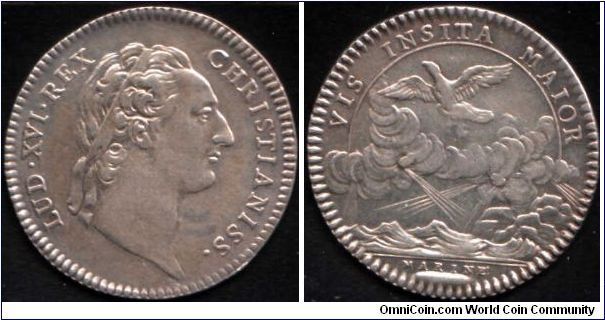
So, here we have two jetons much the same to the casual observation, but their stories are twenty five years apart. The stories span the life of two French kings; relate to the historic events leading to and having decisive effect on the war of independence. French jetons they may be, but their history relates to three nations.
-
Wow! A nice collection you have there.

Ian
-
1795 Halfpenny sized Conder Token. Yorkshire, York. Obverse: York Cathedral. Reverse: Clifford's Tower A.D. 1100 DH.63
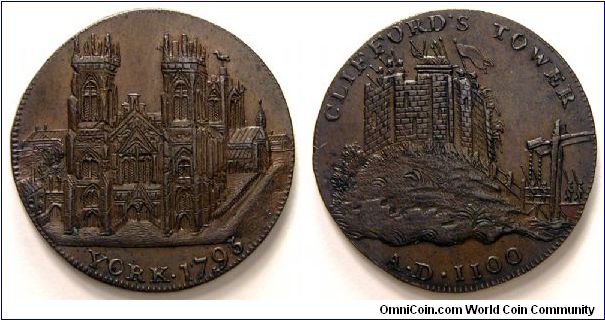
1794 Halfpenny sized Conder Token. Somersetshire, Bath. Botanic Gardens Gate. Scriptures. Tree and ruins. Scriptures. DH.26
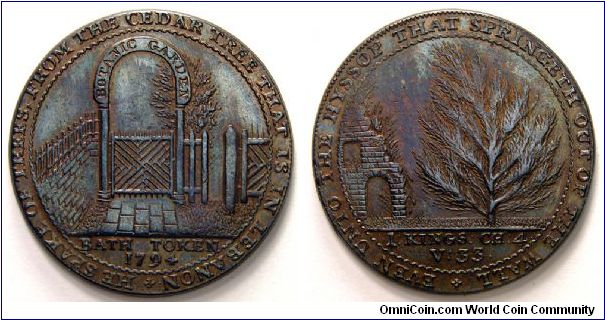
1794 Halfpenny sized Conder Token The Union of Appledore Kent around windmill. Peace Innocence and Plenty around lion and lamb. DH.3.
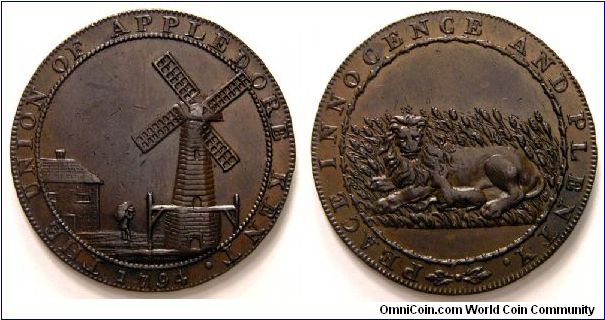
All beautiful high grade conders.
 Congratulations. I'm envious of your York one in particular!
Congratulations. I'm envious of your York one in particular!Ian


Swiss Shooting Medals
in Exonumia (Tokens, Medals, etc) Forums
Posted
Hi Rod. Although I might not be quite as enthusiastic as you are in relation to collecting these items, I certainly have an appreciation for the quality of artistry and strike achieved. I look forward to learning more from you and seeing some more of your collection. That's a real beauty you posted!
You also mentioned my favourite collecting area...jetons Do you also collect french jetons or did you mean Swiss?
Do you also collect french jetons or did you mean Swiss?
Ian